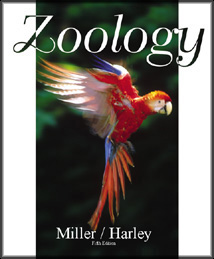 |
1 |  | 
______ is the study of the kinds and diversity of organisms and the evolutionary relationships among them. |
|  | A) | Systematics |
|  | B) | Nomenclature |
|  | C) | Biogeography |
|  | D) | Bhylogenetics |
 |
 |
2 |  | 
A group of animals that shares a particular set of characteristics forms an assemblage called a/an |
|  | A) | intron. |
|  | B) | photon. |
|  | C) | exon. |
|  | D) | taxon. |
 |
 |
3 |  | 
Which of the following sequences is arranged from broad to more specific? |
|  | A) | kingdom, domain, phylum, class, order, family, genus, species |
|  | B) | kingdom, phylum, class, order, domain, family, genus, species |
|  | C) | domain, kingdom, phylum, class, order, family, genus, species |
|  | D) | domain, kingdom, phylum, class, family, order, genus, species |
 |
 |
4 |  | 
Which of the following is the correct way to write the scientific name of the water penny beetle? |
|  | A) | Psephenus herricki |
|  | B) | Psephenus Herricki |
|  | C) | Psephenus Herricki |
|  | D) | Psephenus herricki |
 |
 |
5 |  | 
Prokaryotic organisms that live in extreme environments, such as high-temperature rift valleys on the ocean floor, belong to the domain |
|  | A) | Protista. |
|  | B) | Eubacteria. |
|  | C) | Archaea. |
|  | D) | Eukarya. |
 |
 |
6 |  | 
Animalia can be distinguished from Plantae because |
|  | A) | animals are heterotrophic. |
|  | B) | animal cells have cell walls. |
|  | C) | plants are prokaryotic. |
|  | D) | plants obtain nutrients by absorption. |
 |
 |
7 |  | 
A taxonomic character is any |
|  | A) | trait of an animal. |
|  | B) | genetic trait. |
|  | C) | genetic trait that can be measured. |
|  | D) | genetic trait that determines an anatomical feature of an animal. |
 |
 |
8 |  | 
A taxonomic grouping that is derived from a single ancestor but does not include all members of the family group is called a ______ group. |
|  | A) | paraphyletic |
|  | B) | polyphyletic |
|  | C) | monophyletic |
|  | D) | diphyletic |
 |
 |
9 |  | 
The goal of systematic studies is to arrange animals into |
|  | A) | monophyletic groups. |
|  | B) | polyphyletic groups. |
|  | C) | paraphyletic groups. |
|  | D) | outgroups. |
 |
 |
10 |  | 
A character that can be used to distinguish an animal from other animals within the group is called a |
|  | A) | synapomorphy. |
|  | B) | symplesiomorphy. |
|  | C) | paraphyletic character. |
|  | D) | polyphyletic character. |
 |
 |
11 |  | 
A structure that is near the plane that divides an animal into equal left and right halves is _______ in position. |
|  | A) | medial |
|  | B) | anterior |
|  | C) | lateral |
|  | D) | distal |
 |
 |
12 |  | 
The development of a coelom in an animal is always associated with |
|  | A) | bilateral symmetry. |
|  | B) | asymmetry. |
|  | C) | diploblastic organization. |
|  | D) | triploblastic organization. |
 |
 |
13 |  | 
The dorsal surface of a frog is at the frog's: |
|  | A) | rear end |
|  | B) | head end |
|  | C) | back |
|  | D) | belly |
 |
 |
14 |  | 
The Eubacteria are the most primitive life forms known. |
|  | A) | True |
|  | B) | False |
 |
 |
15 |  | 
In a monophyletic grouping, there is often more than one kind of ancestral animal. |
|  | A) | True |
|  | B) | False |
 |
 |
16 |  | 
Triploblastic animals whose mesodermally derived tissues form a relatively solid mass of cells between
ectodermally and endodermally derived tissues are said to be acoelomate. |
|  | A) | True |
|  | B) | False |
 |
 |
17 |  | 
The formation of a distinct head is called cephalization and is usually associated with bilateral symmetry. |
|  | A) | True |
|  | B) | False |
 |
 |
18 |  | 
The ankle is distal to the knee. |
|  | A) | True |
|  | B) | False |
 |
 |
19 |  | 
The anterior end of a sea anemone contains its tentacles and mouth. |
|  | A) | True |
|  | B) | False |
 |
 |
20 |  | 
A coelom is a body cavity that is completely surrounded by mesodermally derived tissues. |
|  | A) | True |
|  | B) | False |
 |
 |
21 |  | 
A transverse plane divides a bilateral animal into left and right mirror images. |
|  | A) | True |
|  | B) | False |
 |



 2002 McGraw-Hill Higher Education
2002 McGraw-Hill Higher Education